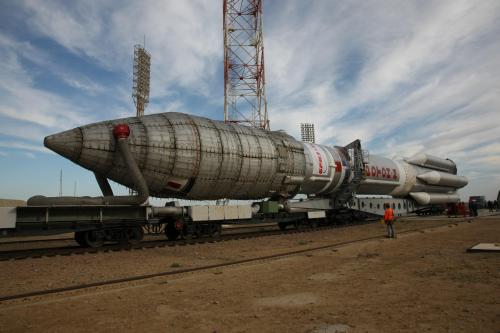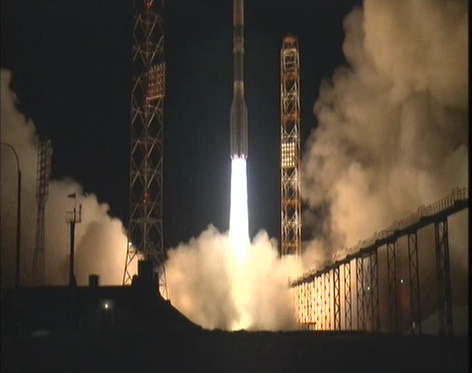
International Launch Services (ILS)—a joint U.S.-Russian company, headquartered in Reston, Va.—is ready to fly its second Proton-M mission in three weeks, with a nighttime liftoff scheduled to take place from Pad 39 at Site 200 at the Baikonur Cosmodrome at 12:12:56 a.m. local time on Monday, 21 October (2:12:56 p.m. EDT on Sunday, 20 October) to deliver the Sirius FM-6 digital radio satellite into geostationary transfer orbit. Coming hard on the heels of ILS’s spectacular 29 September Return to Flight mission, this launch will help to restore confidence in the mighty Proton, which suffered a dramatic failure in July, seconds after leaving the pad.
Aside from the Proton’s woes in 2013, the launch of Sirius FM-6 has met with significant delay thanks to technical difficulties with the satellite itself. Originally targeted to fly in early 2012, it has spent almost two years on the ground, following concerns about a possible solar array defect. A short-lived glitch with the array deployment mechanism on the SES-4 satellite—a spacecraft of similar design and construction—prompted a decision to return Sirius FM-6 to prime contractor Space Systems/Loral’s (SS/L) facility in Palo Alto, Calif., for additional work. Launch was eventually rescheduled for 20 July 2013, but was further postponed after the 2 July explosion of a Proton-M.
Preparations resumed in earnest in early September, when Sirius FM-6 was delivered to Baikonur for final pre-launch processing. The satellite is assembled around SS/L’s LS-1300 “bus,” which was originally introduced in the 1980s and in its current incarnation can provide 5-25 kW of continuous electrical power throughout a project 15-year orbital lifespan. Lightweight and high-strength in construction, the LS-1300 can support as few as 12 and as many as 150 transponders. After insertion into orbit, Sirius satellites receive “Radiosat” designations to differentiate from a Swedish network of communications satellites, which are also known as Sirius.

In June 2000, ILS successfully lofted the 8,400-pound (3,800-kg) Sirius FM-6 (Radiosat-1) atop a Proton-K booster from Baikonur, injecting it into a highly elliptical, high-inclination geosynchronous orbit, known as a “tundra orbit,” from where it provided satellite radio communications services across North America. The FM-2 (Radiosat-2) mission was launched in September 2000, followed by FM-3 (Radiosat-3) in November. All three were placed into tundra orbits, completing a circuit of Earth in about 23 hours and 56 minutes, or one solar “day,” whose characteristics cause the satellites to spend most of their time over a specific point on Earth, known as “apogee dwelling.” The effect was that the Sirius/Radiosat satellites follow a predictable pattern in the sky at the same time, day after day, and the shape of their trajectories described a closed figure-eight.
Tundra orbits—with an apogee of about 29,200 miles (46,990 km) and a perigee of about 14,900 miles (23,980 km)—provide high-latitude users with higher elevation angles than can be offered by a geostationary orbit. The three Sirius/Radiosats spend about 16 hours of each solar day over the continental United States, with at least one of them over the country at all times. Sirius FM-4 (Radiosat-4) was built as a flight-ready spare and in October 2012 was donated to the National Air and Space Museum for display in the James S. McDonnell Space Hangar of the Steven F. Udvar-Hazy Center in Washington, D.C., to “tell the story of modern satellite communications and its powerful impact on everyday life.”
An uprated satellite, Sirius FM-5 (Radiosat-5), was launched in June 2009. Unlike its predecessors, which occupied tundra orbits, the 12,830-pound (5,800-kg) Sirius FM-5 was the first to be placed into geostationary orbit. Whereas its predecessors carried traditional parabolic reflecting antennas, the new satellite was equipped with a 30 foot (9.1 meter) unfurlable reflector, and its geostationary location was reportedly chosen because it allowed for more consistent reception for fixed-location users. By the time that Sirius FM-5 began operations in September 2009, contracts for the construction of Sirius FM-6 had already been signed.

The launch on the night of 20/21 October will be conducted under the auspices of ILS, which has exclusive rights to all Proton missions from Baikonur. Flown 71 times since April 2001—with six failures and two partial failures—the current Proton-M version of the rocket comprises three main stages and for the Sirius FM-6 mission will also utilize the restartable Briz-M upper stage. The vehicle has been built by Russia’s Khrunichev Research and State Production Centre and its heritage extends back to the mid-1960s, with a cumulative launch history of 389 flights and one of the most reliable track records in the world. All of its stages, including the Briz-M, use nitrogen tetroxide and unsymmetrical dimethyl hydrazine propellants. Its first stage consists of a central oxidizer tank, surrounded by six outboard fuel tanks, each fed by an RD-276 engine, and these will provide the initial impetus to boost Sirius FM-6 toward orbit.
On Tuesday, 15 October, the Proton-M was rolled out of its assembly building to begin the one-day process of fueling the Briz-M upper stage. On Wednesday, the State Commission gave its formal approval for the rollout of the Proton-M/Briz-M to Pad 39 at Baikonur’s Site 200 launch zone. At 6:30 a.m. local time Thursday, 17 October (8:30 p.m. EDT Wednesday, 16 October), with the Sirius FM-6 payload aboard, the vehicle was transported in a horizontal orientation to the pad. “A perfectly clear day, albeit chilly for mid-October,” noted ILS on its website, “the temperature was just 6 degrees Celsius. Despite the low temps the teams managed the long day and the ILS Proton now stands vertical on the pad, always a great sight.”
Fueling of the main three stages of the Proton is expected to begin on the pad, about nine hours ahead of liftoff. At T-5 minutes, the Briz-M will be transferred to internal power and confirm its status as healthy. Ignition of the six first-stage RD-276 engines will commence at T-2 seconds, ramping up to 100 percent to produce 2.3 million pounds (1.04 million kg) of thrust at liftoff. A little over a minute into the ascent, the Proton will encounter the period of maximum aerodynamic turbulence (known as “Max Q”) on its flight surfaces, with the separation of the first stage scheduled at the two-minute point. The second stage will then pick up the baton, with its four engines generating a combined 540,000 pounds (244,950 kg) of impulse for a little over 3.5 minutes. Shortly after the second stage separates from the vehicle, the Payload Fairing (PLF) will be jettisoned and the single-engine third stage will add an extra 138,000 pounds (62,600 kg) of thrust for the next four minutes of flight. Shutdown of the third stage is expected about 10 minutes after launch, by which time the vehicle will have been placed onto a suborbital trajectory.
“From this point in the mission, the Briz-M will perform planned mission maneuvers,” noted ILS in its Media Advisory for the launch, “to advance the orbital unit first to a circular parking orbit, then to an intermediate orbit, followed by a transfer orbit, and finally to a geostationary transfer orbit.” The single-engine upper stage has exhibited a mixture of success and failure since its maiden voyage, back in May 2000. In August 2012, a premature shutdown of the Briz-M left Indonesia’s Telkom-3 and Russia’s Ekspress-MD2 satellites in useless orbits, and in December 2012 another launch glitch impacted the Yamal-402 satellite. Last March, a Proton-M/Briz-M successfully injected Mexico’s Satmex-8 communications satellite into orbit, and on 29 September another vehicle transported Astra 2E perfectly into orbit. Capable of restarting up to eight times in flight, the Briz-M has a battery-powered lifetime of 24 hours and is scheduled to execute five “burns” to insert Sirius FM-6 into orbit.
Its first burn will last 4.5 minutes and is due to commence about 11 minutes into the mission, after which the Briz-M/Sirius FM-6 combo will enter a circular “parking orbit” and coast for almost an hour, preparatory to the second burn. This will be a much longer firing of almost 18 minutes, followed by a two-hour period of coasting, then a third burn of 11.5 minutes and a fourth of about six minutes in duration. After the fourth burn, the combo will coast for about five hours, ahead of the final scheduled Briz-M firing at T+8 hours and 52 minutes. This six-minute burn will position Sirius FM-6 into geostationary transfer orbit, and at T+9 hours and 12 minutes the satellite will separate from the upper stage. Sirius FM-6 (Radiosat-6) will enter an operational orbit at 115 degrees West longitude, covering the western half of the contiguous United States.
Want to keep up-to-date with all things space? Be sure to “Like” AmericaSpace on Facebook and follow us on Twitter: @AmericaSpace
Missions » SIRIUS FM-6 »


